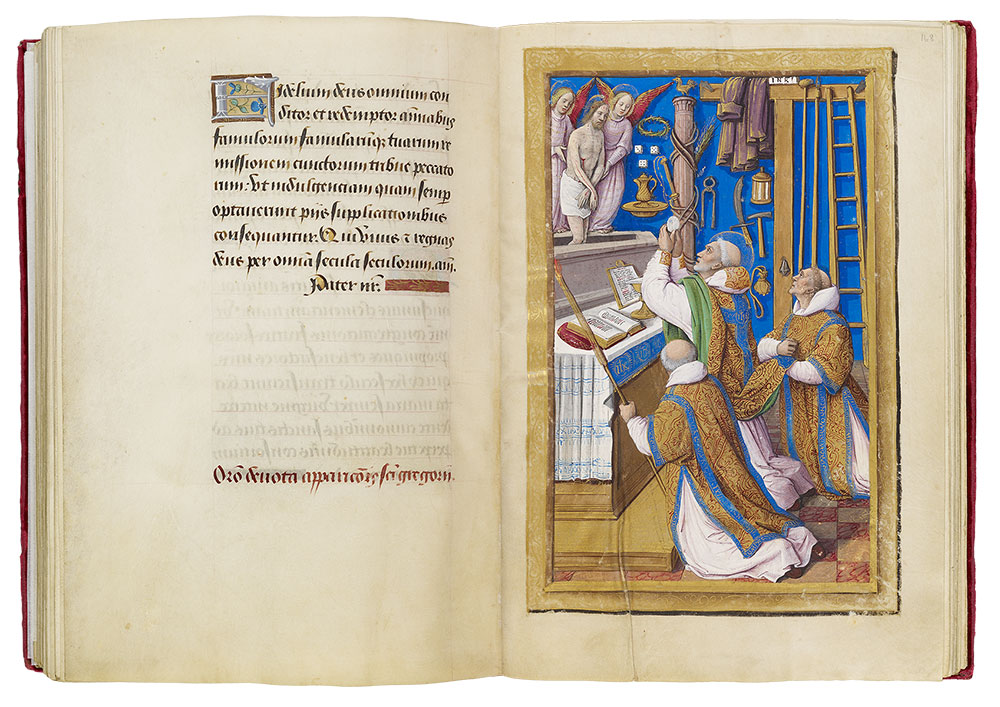
Mass of St. Gregory
Hours of Henry VIII
Illuminated by Jean Poyer
Gift of the Heineman Foundation, 1977
Mass of St. Gregory (fol. 168)
The typical illustration for the Seven Prayers of St. Gregory is the so-called Mass of St. Gregory, an image that apparently was invented in the fifteenth century.
Against the blue background are the arma christi (arms of Christ), which were part of the Man of Sorrows iconography.
A pictographic summary of Christ's Passion makes it possible for the devout to contemplate the enormity of Christ's sufferings; the symbols include the purse (Judas's betrayal for thirty pieces of silver), lantern (Christ was taken at night), sword (with which Peter cut off Malchus's ear), ewer and dish (with which Pilate washed his hands of guilt), cock (crowed when Peter denied he was a disciple of Christ), column with rope and two kinds of scourges (Flagellation), purple garment and Crown of Thorns (Mocking of Christ), Cross (Carrying of Cross), hammer and three nails in Cross with titulus (Crucifixion), three dice (soldiers gambled for Christ's garments), spear with sponge (Christ took vinegar), spear (Christ's side opened, with outpouring of blood and water), and pincers and ladder (for the Deposition).
Gregory, holding the wafer (itself decorated with the Crucifixion) between the first finger and thumb of both hands, recites the words Hoc est enim corpus meum (For this is my Body).
St. Gregory, assisted by a deacon and subdeacon, elevates the consecrated Host during a High Mass. As is liturgically correct, the subdeacon holds a torch, while the deacon lifts the back of Gregory's chasuble, which, like the altar frontal, is embroidered with the monogram of Jesus (IHS).
The live and bleeding Christ miraculously appears on the altar, supported by two angels above his sarcophagus.
Seven Prayers of St. Gregory (fols. 168v–69v)
As discussed above in connection with the accessory Prayers to the Virgin, in addition to the main texts of Books of Hours, a fairly large number of optional texts and prayers could be included, depending on the piety and pocketbook of the patron. Aside from individual prayers, these could include various Hours (of St. Catherine, of St. John the Baptist, and of the days of the week), special Masses (for saints and the days of the week), and a group of devotions organized around the number seven (Seven Joys of the Virgin, Seven Requests to Our Lord, Seven Last Words of Our Lord, Seven Verses of St. Bernard, and the present Seven Prayers of St. Gregory).
According to tradition the Seven Prayers were written by St. Gregory the Great, the fourth Latin Doctor of the Church (as the rubric for the prayers states in a contemporaneous Rouen Horae also in the Morgan Library's Heineman Collection: MS H.1, fol. 114v). The prayers consist of seven short ejaculations addressed to Christ, each followed by an Our Father and Hail Mary. The first begins:
O Domine Ih[es]u Christi adoro te in cruce pendente[m] et coronam spineam
in capite portantem. Deprecor te ut crux tua liberet me ab angelo percutiente.
(O Lord Jesus Christ, I adore you, hanging on the Cross and wearing the Crown of
Thorns on your head. I beseech you so that your Cross might free me from the
persecuting angel.)
The other six prayers (all beginning "O Domine Ihesu Christi adoro te . . . ") relate to the bleeding Christ, the dying Christ, the Entombment, the Descent into Hell, the Resurrection, and Christ as the Good Shepherd. In the present manuscript the text is preceded by a rubric (fol. 167v) identifying it as a devotional prayer of the Vision of St. Gregory ("Or[ati]o devota apparic[i]o[n]is s[an]c[t]i Gregorii").
Mass of St. Gregory
The initial seed for the story of the Mass of St. Gregory, a ninth-century biography of Gregory, was popularized in the Golden Legend. As Gregory was consecrating the Host during Mass, the woman who baked it laughed in disbelief that her kneaded dough would become the Body of Christ. Instead of giving her communion, he placed the wafer on the altar, praying to God for her unbelief. When the woman saw the host change into a piece of flesh in the form of a finger, she immediately rejoined the faithful; thereafter the flesh again became bread and she took communion. About 1400, however, owing to the growing emphasis fostered by Franciscans on Christ's human suffering—especially in the Meditations on the Life of Christ—the story circulated that the Man of Sorrows himself appeared on the altar. Around the same time a variant story developed to explain the thirteenth-century wonder-working mosaic icon of the Imago pietatis in Santa Croce in Gerusalemme in Rome. It was believed to have been commissioned by Gregory himself after, in a Mass, he asked God to change the wine into real blood; in that story Christ appeared on the altar and his blood flowed into the chalice. Indulgences were granted to pilgrims praying before the Santa Croce image, and under Pope Urban VI (r. 137–89), they applied equally to copies of it, which later included prints. Such indulgences were also attached to representations of the Mass of St. Gregory, although none is cited in the present manuscript (a French Horae of about 1485 in Baltimore, Walters Art Gallery, MS W.245, offered, for example, an indulgence of 46,000 years).
